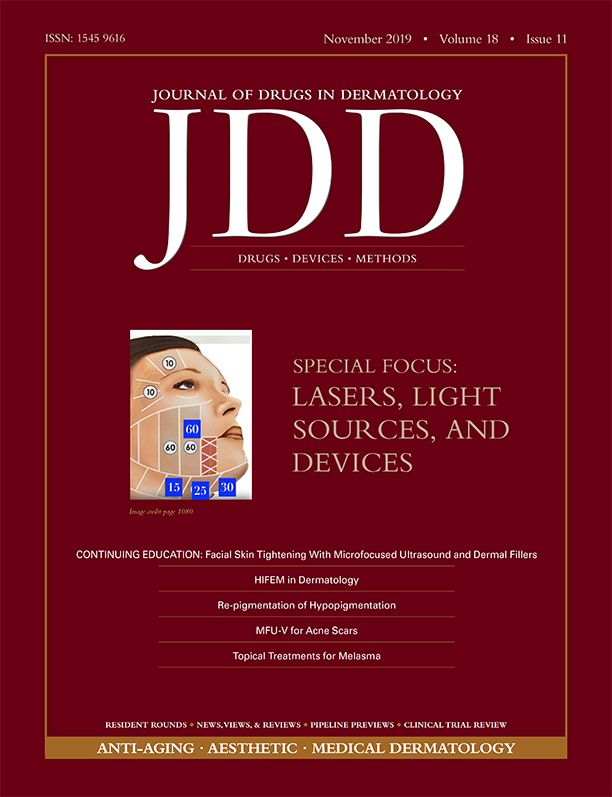Here are the highlights for the November issue of JDD, which has a special focus on lasers, light sources, and devices.
Facial Skin Tightening With Microfocused Ultrasound and Dermal Fillers: Considerations for Patient Selection and Outcomes reviews of the application of microfocused ultrasound in combination with injectable dermal fillers as a treatment approach for lifting skin on the neck and face and for improving lines and wrinkles on the chest. (Note: This article is available for CE Credit)
As the laser, light, and energy-based device field evolves, we should continue to emphasize the importance of rigorous research and long-term clinical trials in High Intensity Focused Electromagnetic Field (HIFEM) Devices in Dermatology, a Guest Editorial by Macrene Alexiades MD PhD.
New and emerging therapies have shown promise in helping with a frequent therapeutic challenge in Re-pigmentation of Hypopigmentation: Fractional Lasers vs Laser-Assisted Delivery of Bimatoprost vs Epidermal Melanocyte Harvesting System.
Simultaneous Changes in Abdominal Adipose and Muscle Tissues Following Treatments by High-Intensity Focused Electromagnetic (HIFEM) Technology-Based Device: Computed Tomography Evaluation investigates the effects of HIFEM for induction of changes in abdominal muscles and abdominal subcutaneous fat.
A Randomized, Controlled, Split-Face Study of the Efficacy of Picosecond Laser in the Treatment of Melasma examines the safety and efficacy of a novel picosecond laser for the treatment of melasma.
MFU-V therapy is beneficial and well tolerated for the treatment of rolling- and boxcar-type acne scars in Safety and Effectiveness of Microfocused Ultrasound With Visualization for the Correction of Moderate to Severe Atrophic Acne Scars.
Safety and efficacy of an IPL device used to induce anti-inflammatory effects was assessed in Combined 400-600 and 800-1200nm Intense Pulsed Phototherapy of Facial Acne Vulgaris.
Authors discuss Improper Potency and Impurities in Compounded Polidocanol used for treatment of spider veins and reticular veins in the lower extremities.
At week 12, efficacy in adult females with moderate acne treated was significantly greater than that reported with vehicle in Efficacy and Tolerability of Tretinoin 0.05% Lotion for the Once-Daily Treatment of Moderate or Severe Acne Vulgaris in Adult Females.
A post hoc analysis studies the impact of gender and race in Tretinoin 0.05% Lotion for the Once-Daily Treatment of Moderate-to-Severe Acne Vulgaris: Impact of Gender and Race on Efficacy and Safety.
A cleansing routine reduced the number of physician-scored inflammatory and non-inflammatory lesions in treated subjects in A Cohort Study Using a Facial Cleansing Brush With Acne Cleansing Brush Head and a Gel Cleanser in Subjects With Mild-to-Moderate Acne and Acne-Prone Skin.
Topical Treatments for Melasma: A Systematic Review of Randomized Controlled Trials evaluates topical treatments for melasma and provide evidence-based recommendations for clinical use and further research.

